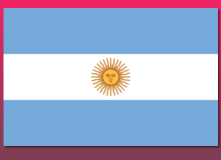The Argentine Wine Industry
Key statistics – regions and varieties
Regional breakdown
Mendoza remains by far the most important wine-growing region in Argentina, accounting for two-thirds of plantings. Total area under wine grape vines, in hectares, of Argentina's wine regions are as follows:
| Mendoza | 148,200 |
| San Juan | 47,200 |
| La Rioja | 8,200 |
| Río Negro | 2,900 |
| Catamarca | 2,400 |
| Salta | 1,900 |
| Neuquén | 1,000 |
| Other provinces (total) | 1,300 |
Vine age
A key advantage in Argentina's bid to produce world-class wines is the fact that more than 50% of the vines in these plantings are over 25 years old, and only 5% are less than 4 years old.
A large proportion (25%) of the vines are between 4 and 8 years old – a result of the widespread moves at that point to rip out volume varieties that were occupying prime sites and replace them with 'premium' varieties including Cabernet Sauvignon, Merlot, and (of course) more Malbec. This was a calculated investment in the future direction of the Argentine wine industry, and it is paying off.
Varieties - red
Further evidence of the evolution in the industry can be seen in the fact that while, in 1990, only 21% of grape production was used for making genuine red wines, the proportion in 2004 had risen to about 44% (the bulk of cheap table wines in Argentina, based on Criolla grapes, are considered rosada, or pink).
The area in hectares devoted to each premium variety in 2004 (the most recent statistics available) are outlined below. The figure in square brackets is the area planted in each variety in 1990. The trends are quite clear:
| Malbec | 21,200 | [10,500] |
| Bonarda | 17,200 | [12,200] |
| Cabernet Sauvignon | 16,200 | [2,300] |
| Syrah | 10,800 | [700] |
| Merlot | 7,100 | [1,200] |
| Tempranillo | 5,600 | [5,700] |
| Pinot Noir (Pinot Negro) | 1,200 | [200] |
| Barbera | 900 | [1000] |
| Cabernet Franc | 300 | [<100] |
Note the incredible expansion in plantings of “new” varieties Cabernet Sauvignon and Syrah, as well as increasing focus on the signature local grape varieties of Malbec and Bonarda. In coming years, expect to see expanding plantings of cooler climate grapes such as Pinot Noir in the Río Negro region.
Varieties – white
A similar trend is present in white premium grape plantings, albeit on a smaller scale:
| Torrontés | 8,000 | [8,600] |
| Chardonnay | 4,800 | [900] |
| Chenin Blanc | 3,100 | [4,000] |
| Ugni Blanc (Trebbiano) | 2,600 | [2,200] |
| Semillon | 1,000 | [1,300] |
| Sauvignon Blanc | 1,200 | [300] |
| Sauvignonasse (Sauvignon Vert) | 700 | [1000] |
| Riesling | 100 | [300] |
Index
- Introduction
- Early beginnings
- Growing grapes in a desert
- Malbec finds a home
- The double-edged sword of domestic demand
- A changing industry
- Key statistics – production and consumption
- Key statistics – regions and varieties
Statistics source: Argentine Instituto Nacional de Vitivinicultura


